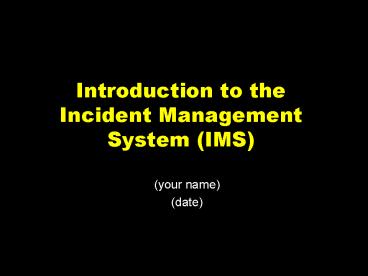Introduction to the Incident Management System IMS - PowerPoint PPT Presentation
1 / 23
Title:
Introduction to the Incident Management System IMS
Description:
Integrated Communications. Modular Organization. Unified Command Structure ... Integrated Communications ... Communications. Finance ... – PowerPoint PPT presentation
Number of Views:308
Avg rating:3.0/5.0
Title: Introduction to the Incident Management System IMS
1
Introduction to the Incident Management System
(IMS)
- (your name)
- (date)
2
NationalInteragencyIncidentManagementSystem
3
NIIMS
- NIIMS was developed to provide a common system
that emergency services agencies can use at
local, State and Federal levels. - It consists of five major sub-systems that
collectively provide a total systems approach to
all-risk incident management. The sub-systems
are
INCIDENT COMMAND SYSTEM
STANDARD TRAINING
QUALIFICATIONS AND CERTIFICATION
PUBLICATIONS MANAGEMENT
SUPPORTING TECHNOLOGIES
4
NIIMS IMS
- Common standards in organization and procedures
- Adaptable to any type of emergency
- Useful for small to complex incidents
- Maintains autonomy of jurisdiction
- Stress total mobility concepts
- Adaptable to new technology
5
NIIMS-IMS
- Eight components
- Common Terminology
- Integrated Communications
- Modular Organization
- Unified Command Structure
- Manageable Span of Control
- Consolidated Action Plans
- Comprehensive Resource Management
- Pre-Designated Incident Facilities
6
IMS Component 1
- Common Terminology
- It is essential for any management system, and
especially one which will be used in joint
operations by many diverse users, that common
terminology be established for the following
elements - Organizational Functions
- Resources
- Facilities
7
IMS Component 2
- Integrated Communications
- Communications are managed through the use of
a common communications plan and an
incident-based communications center established
solely for the use tactical and support resources
assigned to the incident.
8
IMS Component 3
- Modular Organization
- The organizational structure develops in a
modular fashion based upon the kind and size of
an incident. If one individual can
simultaneously manage all major functional areas,
no further organization is required. As the need
exists, four separate Sections can be developed,
each with several Units which may be established.
9
IMS Component 4
- Unified Command Structure
- The concept of unified command means that all
agencies who have a jurisdictional responsibility
at a multi-jurisdictional incident contribute to
the process of - Determining the overall incident objectives
- Selection of strategies
10
- Unified Command Structure, cont
- Ensuring joint tactical planning occurs
- Ensuring joint operations are conducted
- Making maximum use of all assigned resources
11
IMS Component 5
- Manageable Span of Control
- Safety factors as well as sound management
planning will both influence and dictate
span-of-control considerations. In general, the
span-of-control of an individual with emergency
management responsibility should range from three
to seven with a span-of-control of FIVE being
established as a general rule of thumb.
12
IMS Component 6
- Consolidated Action Plans
- Every incident should have some sort of action
plan. For small incidents of short duration, the
plan need not be written. The following are
examples of when written action plans should be
used
13
- Consolidated Action Plans, cont
- When resources from multiple agencies are being
used - When several jurisdictions are involved
- When the incident will require changes in shifts
of personnel and/or equipment.
14
IMS Component 7
- Comprehensive Resource
- Management
- In order to maintain an up-to-date and
accurate picture of resource utilization, it is
necessary that
15
- Comprehensive Resource
- Management, cont
- All resources be assigned a current status
condition (Assigned, Available, or
Out-of-Service). - All changes in resource locations and status
conditions be made promptly to the appropriate
functional Unit.
16
IMS Component 8
- Pre-Designated Incident
- Facilities
- There are several kinds and types of
facilities which can be established in and around
the incident area - Command Post - EOC
- Staging Areas - Labor pool
- Patient Reception Center others ?
17
IMS has 5 Functional Areas
- Command or Management
- Planning
- Logistics
- Finance
- Operations
18
Command or Management
- The Incident Manager is responsible for the
overall management of the incident. The Incident
Manager can have the following staff - Information Officer
- Safety Officer
- Liaison Officer
19
Planning
- The Planning function is responsible for
- The collection, evaluation and dissemination of
tactical information about the incident. - Maintaining information on the current and
forecasted situation, and on the status of
resources assigned to the incident. - The preparation and documentation of action plans.
20
Logistics
- The Logistics Section is responsible for
- providing all service and support needs to the
- incident, such as
- Facilities
- Transportation
- Supplies
- Equipment maintenance and fueling
- Feeding
- Communications.
21
Finance
- The Finance Section is established on
incidents when the agency(s) who are involved
have a specific need for finance services. - In some cases, where only one specific
function is required, like cost analysis, the
position could be established as a Technical
Specialist in the Plans Section.
22
Operations
- Initially, in any incident, the individual
resources that are assigned will be reporting
directly to the individual who has overall
responsibility - the Incident Manager. - As the incident grows in size or complexity,
the Incident Manager may designate an Operations
Chief to assume tactical direction of resources.
23
Questions?
- (your name)
- (contact information)































